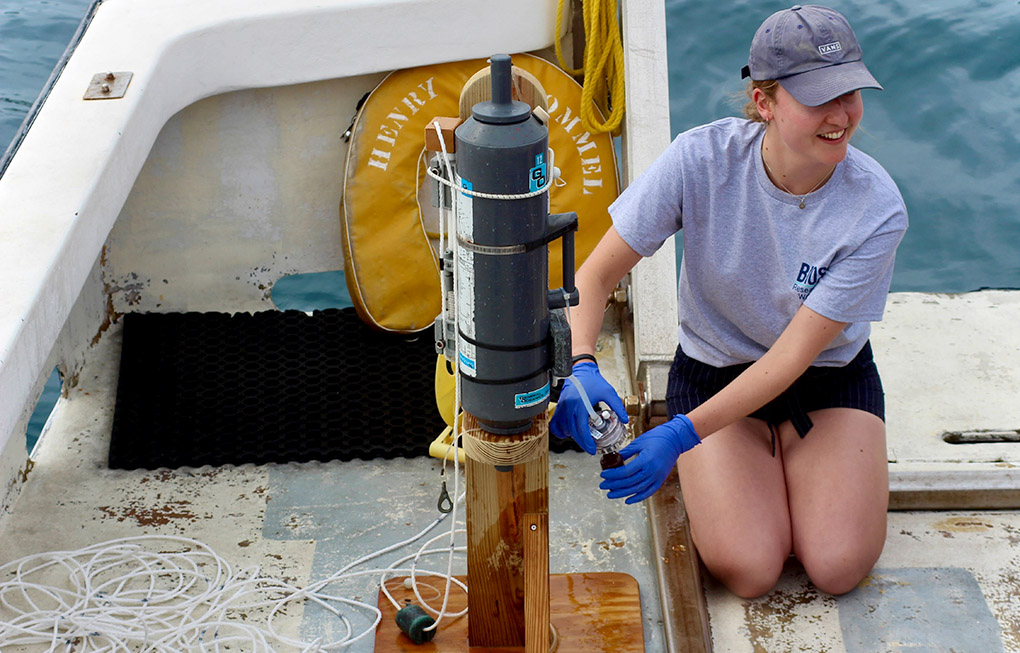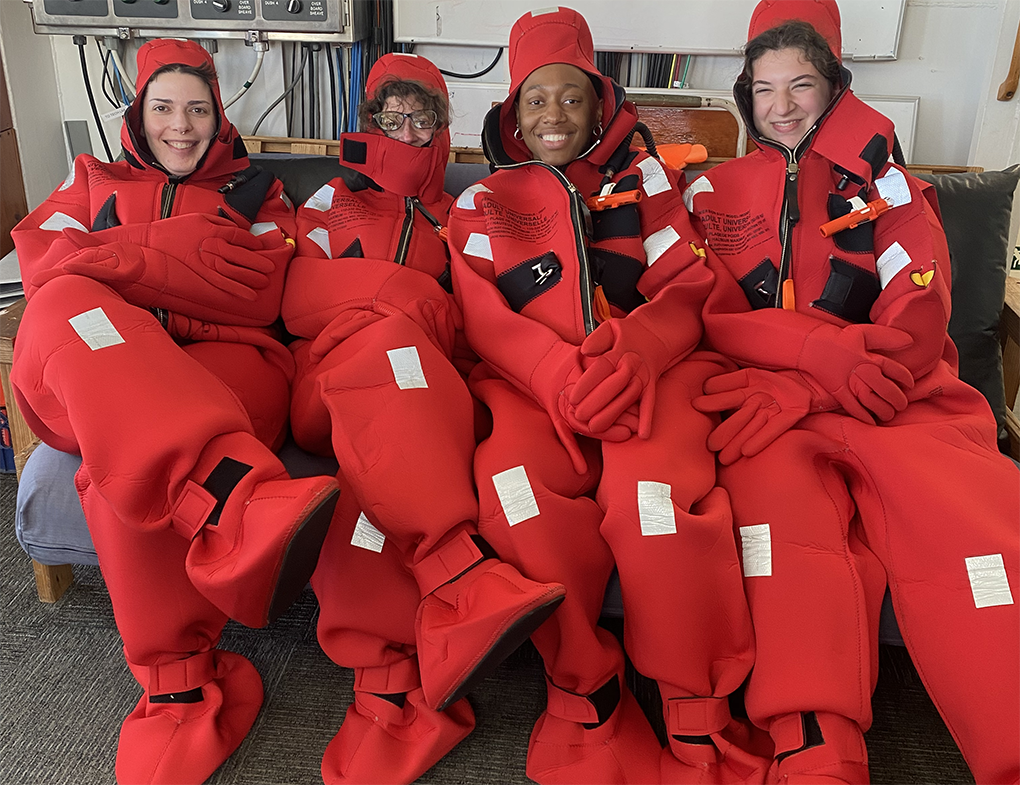Research Week Opens the World of Oceanography for C-CoMP Students

UK Associates of BIOS intern, Amy Jackson, demonstrates collecting water samples from a niskin bottle on a field trip to Devil’s Hole in Harrington Sound, Bermuda, during C-CoMP research workshop.
Wedged between two windy weeks in April, calm weather descended upon Bermuda just as 11 graduate and PhD-bound students arrived at BIOS, primed to head out to sea for a taste of hands-on oceanography under the guidance of Institute scientists, technicians and support personnel.
“This was my first time being at BIOS and I was impressed by the multiple laboratories and the opportunity to board the famous research vessel,” said Dominique Kelly, a Smith College graduate enrolled in a Woods Hole Oceanographic Institution (WHOI) program designed to diversify the marine science community while promoting deeper understanding of the microbial processes that underpin ocean ecosystems.
Noting that her mentor at WHOI, senior scientist Makoto Saito, is a longtime collaborator with the Bermuda Atlantic Time-series Study (BATS) – a deep ocean data set dating back to 1988, Kelly added she was “excited to connect with where the data collection occurs.”
Excitement about opportunities to handle oceanographic equipment, collect and process physical samples, and learn aboard an oceangoing research vessel was a common theme among students who participated in the Center for Chemical Currencies of a Microbial Planet (C-CoMP) research week at BIOS. Based at WHOI and funded with a five-year $25 million National Science Foundation (NSF) grant shared among WHOI, BIOS and eight other marine biology labs and institutions of higher education, C-CoMP aims to foster ocean literacy among students of all ages and promote diversity, equity and inclusion in ocean science research.
Students who traveled to BIOS in April included five graduate students and six who, like Kelly, are part of WHOI’s Bridge-to-PhD program. They were the first of what will be an annual cohort of C-CoMP students hosted by BIOS to “experience ocean science in its reality – the good, the bad, the challenges and the opportunities that presents,” said Nick Bates, senior scientist, director of research and leader of BIOS’s C-CoMP project.
“It’s really to try and foster and support young scientists in their endeavors to continue a career in ocean sciences,” Bates said.
Bates credited three people with directing the “logistics, administration and intellectual drive” of BIOS’s C-CoMP Research Week: WHOI Senior Marine Education Specialist Vicki Centurino, BIOS Microbial Oceanographer Rachel Parsons, and Rachel Gregor, a post-doctoral fellow at the Massachusetts Institute of Technology who was in the first-year cohort of C-CoMP students. Also participating were numerous other BIOS technical and support staff, including several who shared their labs and research with students during the week.

C-CoMP Research week was an initiation to real-world oceanography, an opportunity to not just analyze data but collect and process the samples that produce it – and to study aboard the 170-foot R/V Atlantic Explorer. During a safety briefing onboard, students practice wearing immersion suits.
“It was a fantastic group of students,” Parsons said. “It was interesting to see how excited people got about molecular (biology) and microbes.”
Centurino said Research Week was “initially thought of as a capstone for students in our Bridge-to-PhD program, but it actually fit in better as sort of a beginning experience to show them some of the breadth and also some of the depth that oceanography entails.”
Reflecting on the week recently, Centurino, Parsons and Bates noted that, for most of the students, their experience was an initiation to real-world oceanography, an opportunity to not just analyze data but collect and process the samples that produce it – not to mention study aboard BIOS’s 170-foot R/V Atlantic Explorer, as well as smaller boats.
“Actually having their hands on the equipment, collecting the samples, and processing the samples was absolutely vital in cementing some of these ideas. When you are just learning, making the connection to the actual physical reality is absolutely vital to getting the ideas stacked together in your head,” Centurino said.
“BIOS,” Bates said, “is a great place to have these types of experiences for fostering and continuation of students in ocean sciences – introducing them to the physical nature of going to sea and getting seasick and being almost beyond the sight of land in the deep blue of the Sargasso Sea.”
“Hopefully, it is a bit transformative to the way students are thinking about their futures,” he added.
If a presentation planned for NSF’s annual review of C-CoMP is any indication, the BIOS Research Week was, indeed, transformative. Centurino said WHOI’s six Bridge-to-PhD students planned to present a poster about the week during NSF’s visit to WHOI in late June. Much of the poster presentation accentuates opportunities the week provided for experiences at sea and other activities they hadn’t been exposed to before.
Bates emphasized the relevance of C-CoMP’s focus on the microbial networks, or currencies, that control the carbon cycle in the context of a changing climate. Using BATS for sampling, C-CoMP’s overarching goal is to gain better understanding of organic carbon and photosynthesis in the ocean, the role marine microbes play in recycling organic carbon back to carbon dioxide and whether this is shifting due to environmental impacts such as climate change.
Sharing information about oceanography in the context of climate change and local environmental changes is part of the preparation C-CoMP students received before the BIOS Research Week, Bates said. Similar “lead up activities” will occur before the next cohort of C-CoMP students arrives next year, he said.
